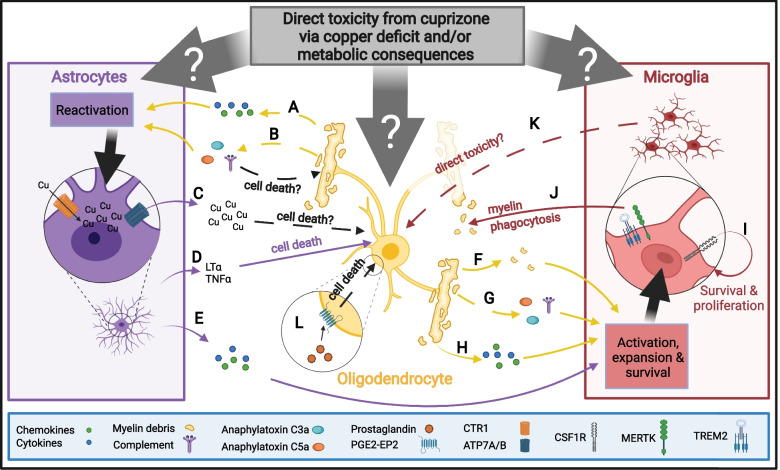Fig. 4.
Proinflammatory response of CNS intrinsic cells resulting from cuprizone intoxication. Cuprizone might directly affect oligodendrocytes, astrocytes, and microglia. Cuprizone-induced demyelination immune response involves multiple – in part overlapping – steps. A As oligodendrocytes die, they release various cytokines and chemokines may lead to activation of astrocytes. B Complement is potentially produced or activated by damaged oligodendrocytes or from myelin breakdown. Activated complement produces anaphylatoxin C3a and C5a, which in turn can attract and activate astrocytes and microglia. Complement may also be directly cytotoxic to oligodendrocytes. C Reactive astrocytes may contribute to copper storage and redistribution in the CNS. The high affinity copper transporter CTR1 mediated copper influx into the astrocytes, while ATP7A/B are mediating copper efflux. This may create a locally toxic copper accumulation or release of factors that exacerbate oligodendrocyte death. Reactive astrocytes also produce (D) cytotoxic chemokines such as LTα and TNFα or (E) proinflammatory cytokines that lead to expansion and activation of microglia. Microglia are also activated when oligodendrocytes release (F) myelin debris, (G) by complement and anaphylatoxin, and (H) cytokines released from the injured oligodendrocyte. I Activated microglia require CSF1R stimulation for survival and proliferation. J Microglia are important for phagocytosis of myelin debris, for which TREM2 and MERTK are crucial. K Activated microglia may exhibit direct toxicity towards oligodendrocytes, (L) Other inflammatory mediators that could lead to oligodendrocyte death such as PG E2 via the PGE2-EP2 receptor

